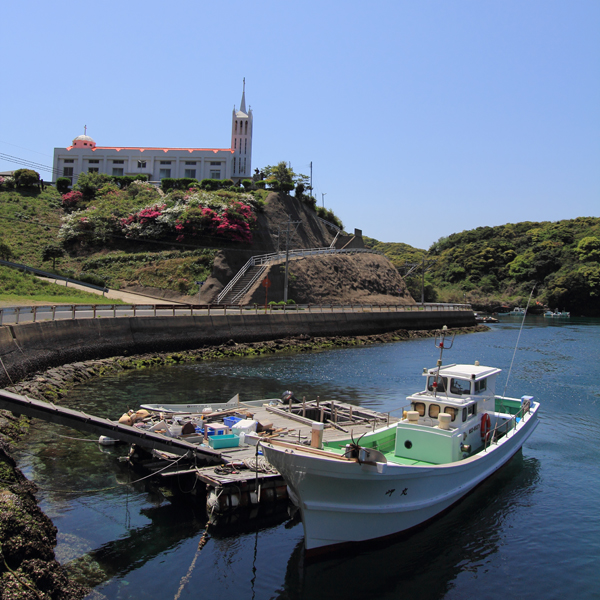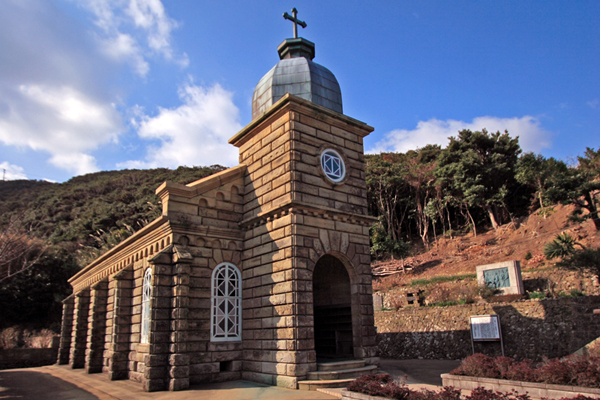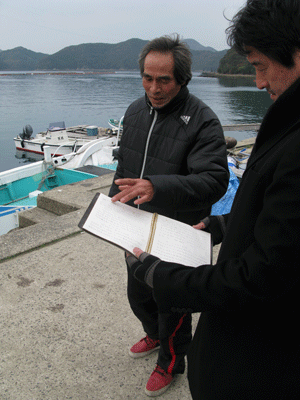Slaughtered for their faith, they fled to the islands off Nagasaki and hid. But who were the Hidden Christians and just what do the Goto Islands have to offer travellers now?
by Matthew Holmes
Only a few hundred yards away from the ferry that has brought us to Fukue, on Nakadori Island, we find ourselves out of its sight, driving along with thick forest to our right and the ocean to our left.
The Goto Islands lie around 100km to the west of Nagasaki city and it has taken us around two hours to get here. The journey, passing signs of local culture, history and industry and underneath Megami Ohashi, the longest suspension bridge in Kyushu, led us away from the spectacular coastline and out into the open water with nothing on the horizon but the occasional tanker, bound for the city or for repairs at the towering Mitsubishi shipyard.
A scattering of people heading to do business joined us but our companions on the ferry had mostly been families returning home; some snoozed with their cars beneath in the hold, some braved the elements outside to take in the view or smoke a cigarette and one young girl excitedly clutched a box of Kentucky Fried Chicken, her souvenir of a rare trip to the mainland. We sure knew we were heading somewhere remote, with a people far removed from the city.
The name of the area literally means “five islands” and we are on the largest of the group, though as we meander towards our first stop around a new coastal road, in and out of natural harbours and inlets with aquarium blue waters that only uninhabited islands and the nets of yellowtail farmers interrupt, it is clear there are many more.
In fact, we learn as we drive that there are 140; some are mere rocks, some are covered in lush vegetation but the vast majority are uninhabited. Small boats chug in and out in calm waters that are rich, we are told, with all manner of shellfish and that are the lifeblood of the area.
Finally we reach Fukaura bay, part of the reason we’re here. We want to learn why the so-called Hidden Christians – the kakure Christians – had come here when disguising their faith lest the rulers of Japan slaughter them.

In Fukuara Bay we spot Kiri Church, one of the island’s 29 churches (photo courtesy of Kami-goto City)
Xavier Brings the Faith
Francis Xavier introduced Christianity to Japan in 1549 and Jesuit missionaries soon spread the word further than the area around Nagasaki that had become the doorway to explorers.
In 1614, though, the Tokugawa Shogunate, after Hideyoshi Toyotomi had expelled missionaries, outlawed a flourishing Christianity. Believers were persecuted, many were crucified and as the “sakoku policy” (which strictly limited private trade with foreign countries) intensified, priests were suppressed, depriving remaining believers of any leadership. Up to 200,000 were said to have given their lives rather than renounce their loyalty to Christ.
Until the Meiji government lifted the ban on Christianity – some 250 years later – there was thought to be no public worship. But when, in 1865, Christians visited Oura Cathedral, in Nagasaki City, they told a tale that would shock. Many had lived secret lives, disguising their religion – sometimes with statues of the Virgin Mary disguised as a Buddhist deity – and practicing underground.
These were the hidden Christians, and they numbered many.
We met Yoshihiro Sakai, the last in the line of kakure Christians who spent generations on the Goto islands after many fled here in secret, and he agreed to take us out on his fishing boat and tell us more.
The hidden Christians are thought to have numbered about 3,000 in 1797, in the late Edo period, each living their lives publicly as farmers and fishermen but privately devoting their prayers and indeed lives to Christianity.
Hiding Among the Rocks
Mr. Sakai took us to an isolated “Christian Cave” on Shirasaki, Wakamatsu Island in which one family had hidden amongst rocks, fearing persecution until smoke from their fire gave them away. A statue of Jesus looks out from the isolated spot, which receives many visitors and has become a sacred site.
Sakai married into the family: “My father-in-law was a priest for around 50 or 60 years, he was a veteran. And he was a seventh generation hidden Christian.” He lived his life as a yellowtail farmer in the bay but when he reached old age could keep his secret no longer.
“He passed it [the secret] to his relatives but when they reached their mid-80s they came to me and asked if I could inherit the tradition as my son was too young, and I accepted.”
Sakai holds on to inherited statues of Rosario and of Jesus that will not see the light of day in public. “They are almost 500 years old,” he tells us. “It was only when my relatives passed them to me that I really knew. My father-in-law did not speak of his faith. After I found out I realized why he’d had so many visitors on Sunday mornings over the years!”
In some ways, though, Sakai has led a more open life than his forefathers.
He tells us of the Oratio – the Christian prayer that has not changed since the missionaries brought knowledge of it in the 1500s. Sakai knows it by heart but worries that it cannot now be so easily passed on so has done something that until now would have been unthinkable: he’s written it down.
Sakai shows us the book – it’s tucked under the boat’s helm. He reads aloud from Latin script written in katakana but doesn’t need to look at it to know his place. He explains that in the knowledge of this prayer many Christians, who could not obtain sacred images or iconography, found their faith could continue.
The Future
Sakai’s son is now 33 and he hopes the family line of priests will be allowed to continue with him. For now, though, he is working and often not on the island:
“When my son retires, when he is 60, I will pass it on to him and I hope he will remember the time he was three and my father in law took him on his rounds.”
His son seems resistant, Mr. Sakai says, to allow these facts into the open. When he inherits the priesthood he will once again shield it.
We spend two days exploring the island by car, visiting many of the 29 remote churches – World Heritage sites amongst them – that serve communities to this day.
The quiet, modest buildings, fusing Japanese and western architecture, are said to reflect the hardships of the periods of persecution. We visit martyrdom sites and learn of a culture unique in the world, not only in Japan, hearing many stories on the way.
World Heritage Islands?
A wild boar scuttled out of the bushes as we walked down from the oldest church on the island to the cemetery by the beach and our guide tells us that the creatures outnumber people on the islands.
Around 20,000 humans live here and we go on to discuss more the area’s current relationship with Christianity. There are around 5,000 Christians on the island – around 25% of the population – a number that is particularly surprising when compared to the ratio in the rest of Japan, around 1% is the figure most often officially used but it is thought to be lower.
In 2015, the 150th anniversary of the “discovery of Christians” the Churches and Christian Sites in Nagasaki will, locals hope, be inscribed as a UNESCO World Heritage Site. Something that was once so secret and hidden, they say, should never be lost.
Main image: Kashiragashima Church in Shin-Kamigoto, an Important Cultural Property of Japan (photo courtesy of Kami-goto City). Other images by the writer.
The Kyushu Shosen ferry company runs from Nagasaki port. It has a website (in Japanese) but you can easily book your ticket in person on the day.
Updated On December 26, 2022











